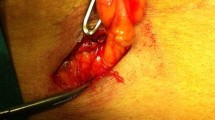Abstract
Background: We designed a study to determine the rate of intra- and postoperative complications as well as the rate of recurrences in elective operated femoral hernias treated via the laparoscopic technique.
Methods: Between 1993 and 1998, we performed 1,097 operations in our department using the laparoscopic transabdominal preperitoneal (TAPP) technique. Femoral hernias amounted to only 4.6% (51 cases) of these patients. The male/female ratio was 1:2. The data concerning the operations and pre- and postoperative treatment were recorded prospectively. The patients were followed up at 2 weeks and 1 year after the operation.
Results: We encountered one intraoperative bladder lesion, one subcutaneous port site infection, two postoperative hematomas that required reoperation, and two nerve irritation syndromes, which disappeared spontaneously after 6 months. Two patients developed an ileus; one required laparoscopic reintervention, and the other was treated with conventional open reoperation and intestinal resection. There were no recurrences.
Conclusions: The application of the laparoscopic approach to the treatment of femoral hernias using the TAPP technique in nonemergency situations is highly effective. To date, we have seen no recurrences. Although the rate of major complications is low, current surgical techniques need to be perfected to avoid the type of complication recognized in this study.
Similar content being viewed by others
References
Bendavid R (1987) A femoral “umbrella” for femoral hernia repair. Surg Gynecol Obstet 165: 153–156
Bittner R, Kraft K, Schmedt CG, Schwarz J, Leibl B (1998) Risiko und Nutzen der laparoskopischen Hernioplastik (TAPP). Chirurg 69: 854–858 DOI: 10.1007/s001040050500
Burton C, Bauer AR Jr (1985) Femoral hernia: a review of 165 repairs. Ann Surg 148: 913–918
Furtschegger A, Sandbichler P, Judmaier W, Gstir H, Steiner F, Egender G (1995) Sonography in the postoperative evaluation of lapara-scopic inguinal hernia repair. J Ultrasound Med 14: 679–684
Glassow F (1985) Femoral hernia—review of 2105 repairs in a 17 year period. Am J Surg 150: 353–356
Hofbauer C, Andersen PV, Juul P, Quist N (1998) Late mesh rejection as a complication to transabdominal preperitoneal laparoscopic hernia repair. Surg Endosc 12: 1164–1165
Koontz AR (1952) Femoral hernia. Arch Surg 64: 298–308
Krähenbühl L, Striffeler H, Baer HO, Büchler MW (1997) Retroperitoneal endoscopic neurectomy for nerve entrapment after hernia repair. Br J Surg 84: 216–219
Kraus A (1993) Nerve injury during laparoscopic inguinal hernia repair. Surg Laparosc Endosc 3: 342–345
Lichtenstein IL, Shore JM (1974) Simplified repair of femoral and inguinal hernia by a “plug” technique. Am J Surg 128: 439–444
Marenem HV, Go PM (1994) Surgical anatomy of the inferior inguinal region: consequences for laparoscopic polyprene mesh hernia repair. Surg Endosc 8: 1212–1215
Miller K, Junger W (1997) Iliocutaneous fistula formation following laparoscopic polypropylene mesh hernia repair. Surg Endosc 11: 772–773 DOI: 10.1007/s004649900448
Ohta J, Yamaguchi Y, Yoshida S, Ishikawa H, Kodama J, Takeda J, Noutomi M, Suematso T, Shirouzu K (1997) Laparoscopic intervention to relieve small bowel obstruction following laparoscopic herniorraphy. Surg Laparosc Endosc 6: 464–468
Patterson M, Walters D, Browder W (1993) Postoperative bowel obstruction following laparoscopic surgery. Am Surg 59: 656–657
Rosen A, Halevy A (1997) Anatomical basis for nerve injury during laparoscopic hernia repair. Surg Laparosc Endosc 7: 469–471
Sanchez-Bustos F, Ramia JM, Fernandez Ferrero F (1998) Prosthetic repair of femoral hernia: audit of long term Follow-up. Eur J Surg 164: 191–193
Seelig MH, Kasperk R, Tietze L, Schumpelick V (1995) Enterokutane Fistel nach Marlex-Netz-Implantation. Chirurg 66: 739–741
Stoppa RE, Rives JL, Warlaumont CR, Palot JP, Verhaege PJ, Delattre JF (1984) The use of Dacron in the repair of hernias of the groin. Surg Clin North Am 64: 269–285
Waddington RT (1971) Femoral hernia: a recent appraisal. Br J Surg 58: 920–922
Author information
Authors and Affiliations
Additional information
Online publication: 13 June 2000
Rights and permissions
About this article
Cite this article
Hernandez-Richter, T., Schardey, H.M., Rau, H.G. et al. The femoral hernia. Surg Endosc 14, 736–740 (2000). https://doi.org/10.1007/s004640000108
Received:
Accepted:
Issue Date:
DOI: https://doi.org/10.1007/s004640000108




